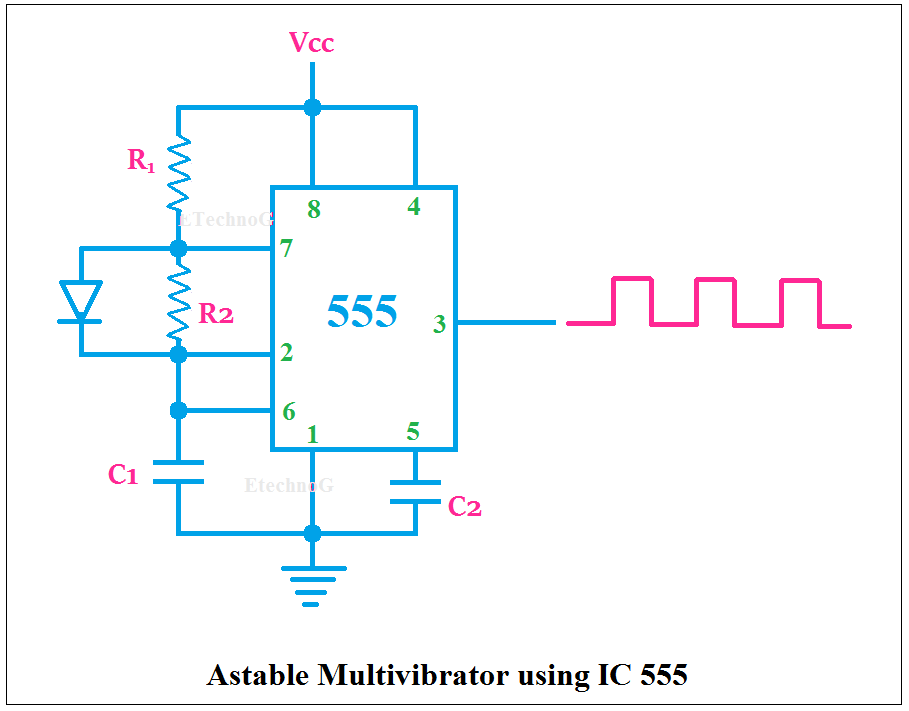Monostable Multivibrator Presentation
| Introduction | ||
|---|---|---|
| A monostable multivibrator is an electronic circuit that generates a single pulse of a specific duration. It is commonly used in various applications such as timing circuits, pulse shaping, and sequential logic circuits. The monostable multivibrator has one stable state and one unstable state. | ||
| 1 | ||
| Basic Operation | ||
|---|---|---|
| The monostable multivibrator circuit consists of a trigger input, a timing capacitor, and a timing resistor. When the trigger input is activated, the circuit switches to its unstable state. The timing capacitor charges through the timing resistor, and the circuit remains in the unstable state until the capacitor reaches a specific voltage level. | ||
| 2 | ||
| Triggering the Circuit | ||
|---|---|---|
| The trigger input can be either a positive or negative pulse, depending on the specific design of the monostable multivibrator. Once the trigger input is applied, it initiates the timing cycle of the circuit. The trigger input can come from an external source or from the output of another circuit. | ||
| 3 | ||
| Timing Components | ||
|---|---|---|
| The timing capacitor and timing resistor determine the duration of the output pulse. The larger the timing capacitor or resistor, the longer the pulse duration. The values of the timing components can be calculated using the desired pulse width and the charging/ discharging characteristics of the capacitor. | ||
| 4 | ||
| Output Pulse | ||
|---|---|---|
| The monostable multivibrator generates a single output pulse when triggered. The pulse width is determined by the timing components and remains constant for a specific circuit configuration. The output pulse is typically a rectangular waveform with a defined rise and fall time. | ||
| 5 | ||
| Applications | ||
|---|---|---|
| Monostable multivibrators are commonly used in applications where precise timing is required, such as in digital systems and communication circuits. They are used for debouncing switches, generating clock signals, and producing time delays. Monostable multivibrators can also be used in combination with other circuits to create more complex timing functions. | ||
| 6 | ||
| Advantages | ||
|---|---|---|
| Monostable multivibrators provide precise control over the duration of the output pulse. They are relatively simple to design and implement. The circuit can be easily triggered by both positive and negative pulses, providing flexibility in various applications. | ||
| 7 | ||
| Disadvantages | ||
|---|---|---|
| Monostable multivibrators are sensitive to noise and external disturbances, which can affect the timing accuracy. The output pulse width is determined by the timing components and cannot be changed during operation. The circuit requires careful selection and calculation of the timing components for the desired pulse width. | ||
| 8 | ||
| Variations | ||
|---|---|---|
| There are different variations of the monostable multivibrator circuit, such as the 555 timer IC and the one-shot multivibrator. These variations offer additional features and functionalities, such as adjustable pulse width and integrated timing components. The choice of the monostable multivibrator circuit depends on the specific requirements of the application. | ||
| 9 | ||
| Conclusion | ||
|---|---|---|
| Monostable multivibrators are essential components in electronic circuits, providing precise timing control. They are widely used in various applications, including timing circuits, pulse shaping, and sequential logic circuits. Understanding the basic operation, triggering, and timing components is crucial for effective utilization of monostable multivibrators. | ||
| 10 | ||





